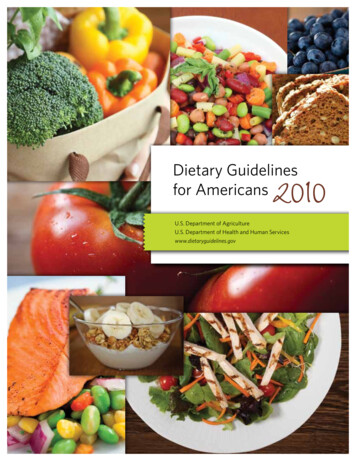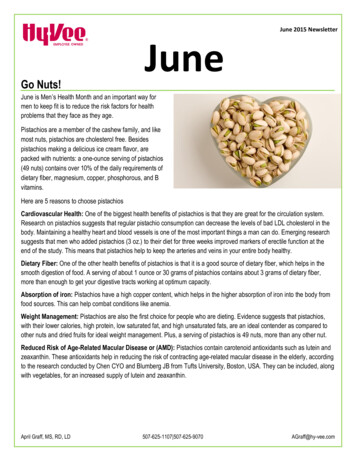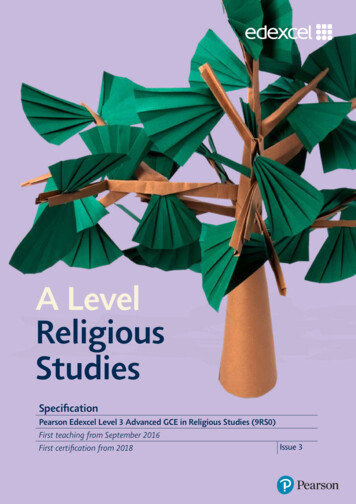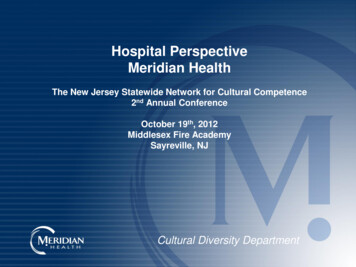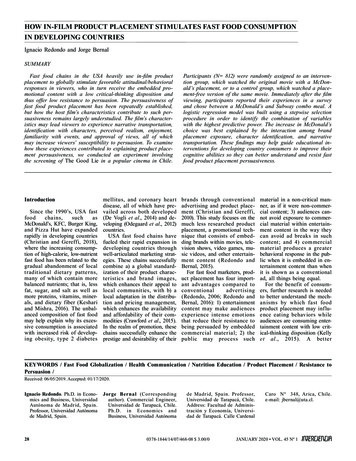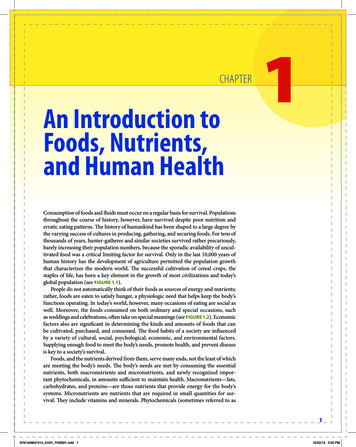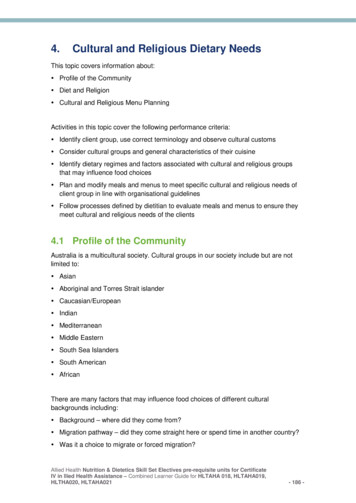
Transcription
4.Cultural and Religious Dietary NeedsThis topic covers information about: Profile of the Community Diet and Religion Cultural and Religious Menu PlanningActivities in this topic cover the following performance criteria: Identify client group, use correct terminology and observe cultural customs Consider cultural groups and general characteristics of their cuisine Identify dietary regimes and factors associated with cultural and religious groupsthat may influence food choices Plan and modify meals and menus to meet specific cultural and religious needs ofclient group in line with organisational guidelines Follow processes defined by dietitian to evaluate meals and menus to ensure theymeet cultural and religious needs of the clients4.1 Profile of the CommunityAustralia is a multicultural society. Cultural groups in our society include but are notlimited to: Asian Aboriginal and Torres Strait islander Caucasian/European Indian Mediterranean Middle Eastern South Sea Islanders South American AfricanThere are many factors that may influence food choices of different culturalbackgrounds including: Background – where did they come from? Migration pathway – did they come straight here or spend time in another country? Was it a choice to migrate or forced migration?Allied Health Nutrition & Dietetics Skill Set Electives pre-requisite units for CertificateIV in llied Health Assistance – Combined Learner Guide for HLTAHA 018, HLTAHA019,HLTHA020, HLTAHA021- 186 -
How old were they? Did they have children and if so how old are their children? Can they speak the language? What is their level of education? Are they able to work and if so do they work outside of the home? Are there other community members here and if so can they access thatcommunity? Are there other family members? Are familiar foods available? Are shopping facilities familiar? Are cooking facilities familiar? What is their income? What are the pressures to conform? Do specific cultural foods have different cultural values?(ASeTTS, 2007)These factors may vary significantly from country to country and region to region andalso within a country. Each cultural group may also have special food traditions;specific ways of preparing, cooking, serving and eating food; special occasions of foodcelebration (feast); and times of fasting or avoidance of certain foods/drinks (e.g. Lentor Eid).Modern changes to the traditional diet are not always healthier particularly when moreprocessed western food is used, which tends to be higher in saturated fat, salt andsugar. Many people prefer bland or traditional foods (i.e. or food from childhood) whenthey are unwell (such as steamed or sticky rice in some Asian diets). Education aboutthe positive aspects of the traditional diet alongside suitable modern choices can beprovided in hospital and may help improve intake during admission and on discharge.Queensland is considered a culturally and religiously diverse state (Australian Bureauof Statistics, 2011: 26.3 % (1 in 4) Queenslanders were born overseas in more than 230 countries( from 17.9% 2006 survey and 16.7% 1996) 23.2% of Qld population spoke a language other than English at homeRecently Queensland Health published a document on community profiles forhealth providers for Queensland Health and is a useful introductory al/health workers/profiles-complete.pdfAllied Health Nutrition & Dietetics Skill Set Electives pre-requisite units for CertificateIV in llied Health Assistance – Combined Learner Guide for HLTAHA 018, HLTAHA019,HLTHA020, HLTAHA021- 187 -
Arrivals in QueenslandPeople from New Zealand and the United Kingdom have been constantly arriving sincebefore 1970. Pre 1970 - Dominated by European arrivals 1970’s – PNG (following independence from Aust) and Vietnam (following Vietnamwar) 1980’s – Philippines, Fiji and China 1990’s – Asian countries (Philippines, Taiwan, Vietnam, China) and South Africa 2000’s – China, India, Philippines, South Korea, JapanReligious affiliations in Queensland (Australian Bureau of Statistics, 2011) Christianity (62.0%) Buddhism (1.5%) Islam (0.8%) Hinduism (0.7%) Other (1.2%) No religion (22.3%) Not stated (12.7%) More than 147,313 (3.4%) people in Qld followed a religion other than Christianity Between 2006 - 2011 the fastest growing religions were Islam and HinduismIncreasing cultural, linguistic, and religious diversity in the Queensland populationmeans that to be safe, health services need to be culturally appropriate andresponsive. Research indicates a strong link between:CulturalincompetencePoor quality healthoutcomes andsignificant risksFigure 9: Link between cultural background and Nutrition (Johnston and Kanitsaki 2005)Allied Health Nutrition & Dietetics Skill Set Electives pre-requisite units for CertificateIV in llied Health Assistance – Combined Learner Guide for HLTAHA 018, HLTAHA019,HLTHA020, HLTAHA021- 188 -
Levels of adherence to a religious or cultural custom are a personal decision. Whilstsome clients prefer to be strict and follow their religious beliefs to be 100% compliant,others may be less strict. Islam, Hinduism, Sikhism, and Buddhism are universal religions which are practicedin many countries around the world Each of these religions place responsibility on the individual to practice his/herreligion Varying degrees of orthodoxy exist; people who follow particular faiths may followfood related customs fully or in part.Personal and cultural variations make it difficult to provide definitive rules andregulations that apply to all patients that identify with a particular religion. Therefore it isbest to consult a patient on an individual/personal level for religious observances.For example, a Muslim from West Africa may have a slightly different way of observingIslam when compared to a Muslim from Bosnia, Indonesia, or Iran.It is important that healthcare providers do not stereotype their clients.Stereotypes assume that all people from certain race, nationality, social group, religion,or culture automatically share the same beliefs and values. Do not assume dietarypreferences: Even if the client appears to comes from a specific group, or is perceived to havecertain cultural affiliations As with all clients, it is best to identify a patient’s individual dietarypreferences/customs and religious observancesAppropriate terminology is vital when communicating with clients from differentcultures. It is essential to be politically correct and non-discriminatory with all clients toreduce the risk of offending clients and their families. Effective communication occurswhen clients and carers have common terms of reference and it is the healthcareproviders responsibility (within reason) to learn and use the terminology that will beused and understood by clients, which includes food and food terminology.Allied Health Nutrition & Dietetics Skill Set Electives pre-requisite units for CertificateIV in llied Health Assistance – Combined Learner Guide for HLTAHA 018, HLTAHA019,HLTHA020, HLTAHA021- 189 -
A Nutrition Assistant is unable to assist a client with food preferences if theydo not recognise/understand what the client is requesting.Resources available to assist with communicating with patients from culturally-diversebackgrounds include: Interpreters– Be aware of your healthcare facilities protocol to access interpreters as usuallybooking in advance is required.– Via phone contact– Face to face – a Nutrition Assistant may be involved directly or indirectly viaDietitian Ward Communication tool Communication tools developed by individual facilitiesQueensland Health provides a list of interpretive resources on their ulticultural/support tools/WCT.aspAllied Health Nutrition & Dietetics Skill Set Electives pre-requisite units for CertificateIV in llied Health Assistance – Combined Learner Guide for HLTAHA 018, HLTAHA019,HLTHA020, HLTAHA021- 190 -
The following pictures/tools are courtesy of Mater Health Services who developedthese tools to help communicate dietary preferences with West African inpatients.Figure 10a: Dietary preference communication tool (West African) (Mater HealthService, 2008)Allied Health Nutrition & Dietetics Skill Set Electives pre-requisite units for CertificateIV in llied Health Assistance – Combined Learner Guide for HLTAHA 018, HLTAHA019,HLTHA020, HLTAHA021- 191 -
Figure 10b: Dietary preference communication tool (West African) (Mater Health Service, 2008)Allied Health Nutrition & Dietetics Skill Set Electives pre-requisite units for CertificateIV in llied Health Assistance – Combined Learner Guide for HLTAHA 018, HLTAHA019,HLTHA020, HLTAHA021- 192 -
There are several factors that influence food choices and these include: Availability Accessibility Familiarity Beliefs and Values Food advertising Cultural preferences Therapeutic diet requirementsCultural preferences Special food traditions/customs Different religious needs Specific ways of preparing, cooking, serving and eating food Holy Days/Festivals/Special Occasions which impact on food intake Fasting or avoidance of certain foods/drinksAllied Health Nutrition & Dietetics Skill Set Electives pre-requisite units for CertificateIV in llied Health Assistance – Combined Learner Guide for HLTAHA 018, HLTAHA019,HLTHA020, HLTAHA021- 193 -
Observing Cultural CustomsNutrition Assistants can provide better nutrition care if they are aware of HolyDays/Festivals/Special Occasions that have an impact on food intake. Festive Occasions and Holy Days– Can carry great significance for many people and the need to acknowledge themis important.– The ability to accommodate special customs and customary foods at this time willcontribute to quality of life, to what the clients recognise to be a normal lifestyle.– Particularly important in Residential Care. Fasting– Ramadan in the ninth month in Islamic year during which most Muslims fast. It isiImportant to know this when monitoring a patient’s intake.A religious Calendar is published in the Queensland Health MulticulturalClinical Support Resource support tools/mcsr.aspAllied Health Nutrition & Dietetics Skill Set Electives pre-requisite units for CertificateIV in llied Health Assistance – Combined Learner Guide for HLTAHA 018, HLTAHA019,HLTHA020, HLTAHA021- 194 -
Activity 20 – Factors Influencing Food ChoicesSelect a member of your local community (can be a friend, family member, etc.) whohas been raised in a county other than Australia. Ask them if they would agree to beinterviewed by you regarding their experiences as a child and then as an adult inAustralia regarding their food experiences.1. In what country was this person born? (or has experience with)2. What types of foods did this person eat in their home country? (Ask them to outlinefor you a typical day’s menu)BreakfastMorning SnackLunchAfternoon SnackEvening MealSupper3. What new foods has the person introduced into their daily menu as a result ofmoving to Australia? (Ask them to outline for you a typical day’s menu)BreakfastMorning SnackLunchAfternoon SnackEvening MealSupper4. Ask the person to list three (3) factors that have influenced their food choices.a)b)c)Allied Health Nutrition & Dietetics Skill Set Electives pre-requisite units for CertificateIV in llied Health Assistance – Combined Learner Guide for HLTAHA 018, HLTAHA019,HLTHA020, HLTAHA021- 195 -
Cultural OverviewThe following overviews of different cultures allow you to gain an understanding of thediverse range of foods and fluids one culture may prefer compared to another culture. Itallows you to see any overlap of foods in the cultures that may be available forselection on a hospital menu and those that may not be accessible or readily available.Some of the cultures you may be working with include:Aboriginal and Torres Strait Islander dietThe Aboriginal and Torres Strait Islander diet has changed from a hunter-gatherlifestyle to a more westernised diet that is typically a high kilojoule, low nutritionallifestyle. Traditionally, Aboriginal and Torres Strait Islander peoples enjoyed a healthydiet of high in carbohydrates, protein, and nutrients, and low in fat and sugars. Withwhite settlement came flour, sugar and processed meat (NHMRC, 2000).Characteristics of Hunter-Gatherer and Western LifestylesHunter gatherer lifestylePhysical activity levelHighWestern lifestyleLowPrinciple characteristics of dietEnergy densityLowHighEnergy intakeUsually adequateExcessiveNutrient oderateHighSimple CarbohydrateUsually lowHighDietary fibreHighLowFatLowhighSodium: potassium ratioLowHighNutrient composition of diet(NHMRC, 2000)Allied Health Nutrition & Dietetics Skill Set Electives pre-requisite units for CertificateIV in llied Health Assistance – Combined Learner Guide for HLTAHA 018, HLTAHA019,HLTHA020, HLTAHA021- 196 -
When providing nutrition support for indigenous Australians, involve localAboriginal and Torres Strait Islander Cultural Liaison Officers, local indigenouscommunities or health organisations wherever possible. They can provide specificinformation about cultural and spiritual needs and methods of catering for the dietaryneeds of these people.Mediterranean DietThe Greek and Italian communities are well-established in Australia. There is a largeamount of integration with mainstream communities, with second and third generationmigrants growing up and sending their children to Australian schools (ASeTTS, 2007)Italian (Gallegos & Perry, 1995)Common foods patients prefer may vary slightly depending on the region in Italy thepatient is from, and the degree of influence from living in Australia for many years.Preferences may include: Pork, veal, chicken, fish, cold meats e.g. salami, prosciutto, mortadella etc., arepopular served with olives, cheeses, pickled vegetables. Vegetables – many people grow their own– E.g. radicchio (bitter lettuce), lettuce, spinach, artichokes, peas, capsicum,tomato, broccoli, broad beans, eggplant, and zucchini.– Pulses - eaten in soups and served with pasta e.g. Lima beans, broad beans,chickpeas and lentils. Bread – usually present at every meal Sweets – served on special occasions.– May be rich liqueur soaked cakes or fritter type pastries.– May contain cream or ricotta cheese. Fruit – the usual ending to a meal. Beverages– Strong black coffee or coffee with milk.– Tea (in Australia). Herbal teas are used for ailments and insomnia.Allied Health Nutrition & Dietetics Skill Set Electives pre-requisite units for CertificateIV in llied Health Assistance – Combined Learner Guide for HLTAHA 018, HLTAHA019,HLTHA020, HLTAHA021- 197 -
Greek (Gallegos & Perry, 1995)Environment and regions determine the type of diet. Common foods often preferredmay vary slightly depending on the region the patient may be from and include: Meats including lamb, chicken, fish, and pork. Beef is used less often. Meatmay be baked, braised boiled, fried, or grilled. Salty seasonings such as anchovies, caviar, cheese, sardines, and salt are verypopular. Vegetables– Many vegetables (e.g. tomato, capsicum, zucchini, and eggplant) are stuffed witha meat and rice filling as a main course.– Leafy greens e.g. chicory and endive with lemon juice and olive oil dressing andsalads. Fruit – dried fruit and nuts are popular Bread is popular Sauces– Traditionally tomato, olive oil, garlic, herbs (oregano and parsley) or egg andlemon.– Herbs and flavourings – parsley, oregano, garlic, celery, mint and bay leaves. Sweets– Often covered in honey syrup. E.g. Greek walnut cake, semolina cake, Halva,filo-pastry with custard, baklava, Greek shortbread. Beverages– Coffee (Greek or instant) and cocoa.Allied Health Nutrition & Dietetics Skill Set Electives pre-requisite units for CertificateIV in llied Health Assistance – Combined Learner Guide for HLTAHA 018, HLTAHA019,HLTHA020, HLTAHA021- 198 -
Polish Meat– Meat, pork in particular.– Baked or fried meats usually come with gravy (red meat), sour cream sauce(white meat); boiled meat is cooked with black peppercorns, salt and bay leaves.– Cold meats such as ham, polish salami and jellied meat like pigs trotters.– Chicken, duck, and game are enjoyed in traditional recipes.– Fish, baked or fried in butter, tinned herrings are popular. Vegetables– Boiled in salted water, sautéed in butter, sprinkled with breadcrumbs, and usuallycooked with sugar, salt, vinegar and cream.– Popular vegetables include cabbage, beets, onions, mushrooms, tomatoes,carrot, spinach, beans, cauliflower, turnips, peas, parsnips, potatoes, capsicum,celery, cucumber, and eschalots.– Salad with lettuce, tomato, onion, cucumber, and radish eaten with sour cream;may accompany main meal. Sweets– Puddings, Kisiel (opaque jelly containing flour), poppy seed cake, jelly, fruit, icecream.– Yeast cakes and torts are served at festivals.(Gallegos & Perry, 1995)Allied Health Nutrition & Dietetics Skill Set Electives pre-requisite units for CertificateIV in llied Health Assistance – Combined Learner Guide for HLTAHA 018, HLTAHA019,HLTHA020, HLTAHA021- 199 -
Bosnia-Herzegovina, Republic of Croatia, Republic of SerbiaEach of these groups is unique in their culture (Gallegos & Perry, 1995).The following is aimed as a guide to possible eating habits and is not a clear definition.General characteristics of the diet: Crusty white bread is common and usually eaten at most meals. Pickled or preserved foods are common. Vegetables are usually dressed with a sauce or fried with onion and garlic and mayhave other sauces with them. Commonly eaten vegetables include potato, silver beet, cabbage, capsicum, beans,peas, sauerkraut, tomatoes, squash, eggplant, pumpkin, cauliflower, and corn. Soups, stews, and goulashes are favoured. Moussakas, pastries, and rice dishes are all commonly eaten. Cornmeal dishes similar to polenta and pasta are also enjoyed. Turkish coffee and sweet desserts and cakes such as baklava are frequently eaten. Condiments and herbs such as fresh tomato sauce, olive oil, paprika, dill, parsley,rosemary, basil and bay leaves are common.Allied Health Nutrition & Dietetics Skill Set Electives pre-requisite units for CertificateIV in llied Health Assistance – Combined Learner Guide for HLTAHA 018, HLTAHA019,HLTHA020, HLTAHA021- 200 -
Asian examplesChineseThere are a number of regions in China that all have different ways of preparing food. Rice is the almost always the basis of a meal. Foods are commonly steamed, boiled or stir fried. Meat and chicken are cut up finely. Beef, pork, and chicken are used in traditional cooking. Fish – whole, steamed with fresh ginger, shallots, dry sherry. Fresh green prawns are preferred to the cooked variety. Stir-fry seafood combinations usually contain scallops, squid, prawns with gingeralong with shallots and Chinese broccoli. Sauces add flavour, e.g. light or dark soy sauce, soybean paste, black bean sauce,prawn paste, oyster sauce, peanut or sesame oil and salty bean curd are often usedin cooking. Soups based on stock with meat and vegetables. Noodles and dumplings are addedfor substance. Wheat flours (noodles, dumplings) are available in northern China while rice is moreavailable in southern China. Vegetables – many varieties are enjoyed for example; Chinese cabbage, Chinesespinach, Chinese broccoli, English spinach, eggplant, snake beans, French beans,celery, carrot, capsicum, marrows, pumpkins, tomatoes, shallots, chives, onion,bamboo shoots, lotus, water chestnuts, sweet potatoes, yams, soybean, mung beansprouts, garlic, ginger, chilli, and shallots. Beverages– Chinese tea or plain water.– Soups are sometimes drunk as refreshers during the meal.– May enjoy fruit juice in Australia. Soft drinks rare at home. Sweets – fruit and sweet snacks, sweet bean soup, sesame seed balls, eggrolls.Allied Health Nutrition & Dietetics Skill Set Electives pre-requisite units for CertificateIV in llied Health Assistance – Combined Learner Guide for HLTAHA 018, HLTAHA019,HLTHA020, HLTAHA021- 201 -
VietnameseRice forms the basis to the diet and is often eaten at each meal although noodles aresometimes used as an alternative. Meats– Pork and poultry such as chicken or duck.– Fish and shellfish are popular. Shellfish and fish bones are a source of calcium inthe diet. Prawn shells and fish bones are used to make stock. Vegetables– E.g. Spring onions, celery, capsicum, mushrooms, cauliflower, cabbage, onion,Chinese cabbage, Chinese mustard greens, bean sprouts, snow peas. Legumesare frequently used.– Salads are usually sprinkled with fresh herbs like parsley or peppermint leaves.– Popular salads include: cabbage, lettuce, watercress, or bean sprouts. Breads – crusty French bread sticks are preferred. Sauces – soy sauce and fish sauce is used for most dishes for flavour. Sweets– Rice cakes and sticky rice dishes are part of festive occasions.– Fresh fruit especially the tropical varieties such as mango, banana, and watermelon. Beverages – Chinese tea or coffee with condensed milk.Allied Health Nutrition & Dietetics Skill Set Electives pre-requisite units for CertificateIV in llied Health Assistance – Combined Learner Guide for HLTAHA 018, HLTAHA019,HLTHA020, HLTAHA021- 202 -
African examplesIMPORTANT: Be aware that some of this information will not be tribe specific,for example, Sudan consists of one geographical country but is populated by more than200 different language groups. Ethnicities can have very different cultures andpractices which will not all be described here (ASeTTS, 2007).The following is a list of foods that are either not common in an Australian context orare used in different ways in Africa. It is not an exhaustive list. Some people from thispart of the world are Muslim and may require access to Halal foods. Bread and cereals– Maize flour can sometimes be called mealie meal and is used to make porridge.– Millet flour.– Flour is used to make the staple porridge eaten alone or as an accompaniment.Sorghum flour is another variety used to make porridge.– Teff is a grain used in Ethiopia to make injera. It is grown in Australia as animalfeed but is currently unavailable for human consumption. Quinoa may be anadequate substitute.– Injera is the Ethiopian/Eritrean name given to flat, fermented bread.– Asida is one of the South Sudanese names for the porridge. Pulses– Black-eyed beans are used extensively both in cooking and as a snack.– All other pulses.– Seeds and nuts.– Tahini is used as a spread and as an addition to stews and vegetable dishes. Fruit– Plantain is like a large green banana. It is quite starchy and is always cooked.– Tamarind Available from Asian food markets in fresh, puree or dried form.– Used to flavour porridge, as a drink or to eat. Dairy– Camel’s milk may be consumed by those coming from Ethiopia, Eritrea, Somaliaand parts of Kenya.– There is no commercial dairy in Australia.Allied Health Nutrition & Dietetics Skill Set Electives pre-requisite units for CertificateIV in llied Health Assistance – Combined Learner Guide for HLTAHA 018, HLTAHA019,HLTHA020, HLTAHA021- 203 -
Vegetables– Sweet potatoes are eaten extensively as are the leaves.– Amaranth also called Chinese spinach.– Cassava is a starchy woody shrub used as flour or grated in savoury or sweetdishes.– Okra.– Molokhia is a small green leaf which is used to thicken stews. Meat– Dried fish is used in many dishes and is often used to flavour stews.– Goat meat is eaten by a number of different African groups. It can be found insome selected butcher’s shops. Italian butchers sell goat as capreto.– Camel meat may be consumed by those coming from Ethiopia, Eritrea, Somaliaand some parts of Kenya. Camel meat may be locally available but this will needto be checked depending on the location of your health service. Fats and Oils– Red Palm Oil is used especially in West Africa and gives food a distinctive taste.It is not readily available but there are some local importers emerging.(ASeTTS, 2007)Allied Health Nutrition & Dietetics Skill Set Electives pre-requisite units for CertificateIV in llied Health Assistance – Combined Learner Guide for HLTAHA 018, HLTAHA019,HLTHA020, HLTAHA021- 204 -
Middle Eastern examplesThe following foods are either not common in an Australian context or are used indifferent ways in the Middle East. It is not an exhaustive list. Many people from this partof the world are Muslim and may require access to Halal foods.Name in EnglishName in ArabicAvailabilityBreadKhoboz wa SamoonBreadSamoonLebanese BreadKhoboz LubnaniTurkish BreadSamoon turkyRice and FlourRooz wa TaheenFruitFakihaApricot and DriedapricotMishmish wamishmash mojefefDatesTemorPruneInjasSultanasKishmishFig and dried FigTeen wa teen mojefefVegetableKhothrewatWhite AlbanYoghurtLebenPlain yoghurt is used extensivelyLabnehLeben MokethefSpreadable yoghurt, is available in somesupermarketsMilkHaleebMany different varieties of milk are used includingcow, sheep, goat and camelMany different varieties of bread are used. Someare leavened breads and others are flat breads. InAfghanistan there is a variety which is called naanwhich is similar to what is called Turkish bread inAustralia.Dried fruit is a common feature in the Middle East. Itis usually eaten as a snackAvailable fresh from Asian food markets. Alsoavailable frozen or canned. Okra is cooked quicklyto retain its crispness or for longer to draw on itsmucilaginous properties.Allied Health Nutrition & Dietetics Skill Set Electives pre-requisite units for CertificateIV in llied Health Assistance – Combined Learner Guide for HLTAHA 018, HLTAHA019,HLTHA020, HLTAHA021- 205 -
PulsesBokoolBlack-eyed BeansLobya Yabsa (Beatha)Broad Beans (dried)Bagilla YabsaBroad BeansBagilla khethraCannellini BeansFasolya Yabsa(Beatha)Chick PeasHommosHaricot BeansLobya khethraLentilsAdassMung BeansMashYellow split peasHommos MajrooshSeeds And NutsAl jGoatLehem MaezLambLehem IgelAll pulses are used extensively as side dishes,additions to main dishes or as snacks.Paste made from sesame seeds used as a spreador a flavouringOften sold as capreto at Italian or specialitybutchers(ASeTTS, 2007)Allied Health Nutrition & Dietetics Skill Set Electives pre-requisite units for CertificateIV in llied Health Assistance – Combined Learner Guide for HLTAHA 018, HLTAHA019,HLTHA020, HLTAHA021- 206 -
IndianFood in India varies from region to region and is strongly influenced by religion andcustom. The wide variety of food that is eaten and the regional variation presented inIndia is too complex to specify, therefore general differences between northern andsouthern India are identified (Gallegos & Perry, 1995).ItemNorthern IndiaSouthern IndiaStapleWheat – eaten as chapattisRiceCurryUsually dry so can be eaten withchapattisUsually wet so that the rice cansoak up juicesSaladRaira made from yoghurt to whichfruit and seasonings are addedSambal a mixture of a relish and asaladFruit and vegetablesA wide variety are eaten throughout IndiaMeatMutton, Chicken, pork. No BeefMainly vegetarianFishRiver FishOcean FishDairyRicotta cheese, yoghurtYoghurt at every mealGheeOilNo coconutCoconutTeaCoffeeLassi (yoghurt drink)ButtermilkFatDrinksIn addition most meals are served with an array of different dishes includingpappadums, pickles, relishes, and raitas. Curries are eaten regularly.Allied Health Nutrition & Dietetics Skill Set Electives pre-requisite units for CertificateIV in llied Health Assistance – Combined Learner Guide for HLTAHA 018, HLTAHA019,HLTHA020, HLTAHA021- 207 -
Activity 21 – Meeting Cultural and Religious Dietary Needs1. List three places where you could source information on the cuisine of variouscultural and religious groups that are found in Australian society.2. Describe how you could access interpreter services for a client in your health carefacility?3. What other services could help you assist culturally diverse clients?Activity continues on the next page.Allied Health Nutrition & Dietetics Skill Set Electives pre-requisite units for CertificateIV in llied Health Assistance – Combined Learner Guide for HLTAHA 018, HLTAHA019,HLTHA020, HLTAHA021- 208 -
Activity 21 – Meeting Cultural and Religious Dietary Needs continuedSelect a religious group which follows dietary restrictions or protocols and answer thequestions below. If possible select a group that you have seen represented in thepatients at your hospital.4. What is the religious group that you have selected? Why?5. What foods or fluids are restricted or forbidden?6. Complete the following sentences.a) According to the Islamic faith, Muslims should: Use meat Avoid all products Avoid drinks and food containing .b) food is food that conforms to Jewish dietary laws.c) Most Hindus do not eat or items containingproducts.Allied Health Nutrition & Dietetics Skill Set Electives pre-requisite units for CertificateIV in llied Health Assistance – Combined Learner Guide for HLTAHA 018, HLTAHA019,HLTHA020, HLTAHA021- 209 -
4.2 Diet and ReligionThere are a number of religious groups within Australian society who may followparticular dietary restrictions. These include, but are not limited to: Some Christian denominations e.g. Seven Day Adventists Jewish Muslim HinduThere is often: Food laws and traditions that are observed. Variability in the level of restriction within religious groups. Changes to food and eating behaviour as a result of feast and fasting occasions(these may occur many times over the year).ChristianityPract
Plan and modify meals and menus to meet specific cultural and religious needs of client group in line with organisational guidelines Follow processes defined by dietitian to evaluate meals and menus to ensure they meet cultural and religious needs of the clients . 4.1 Profi




